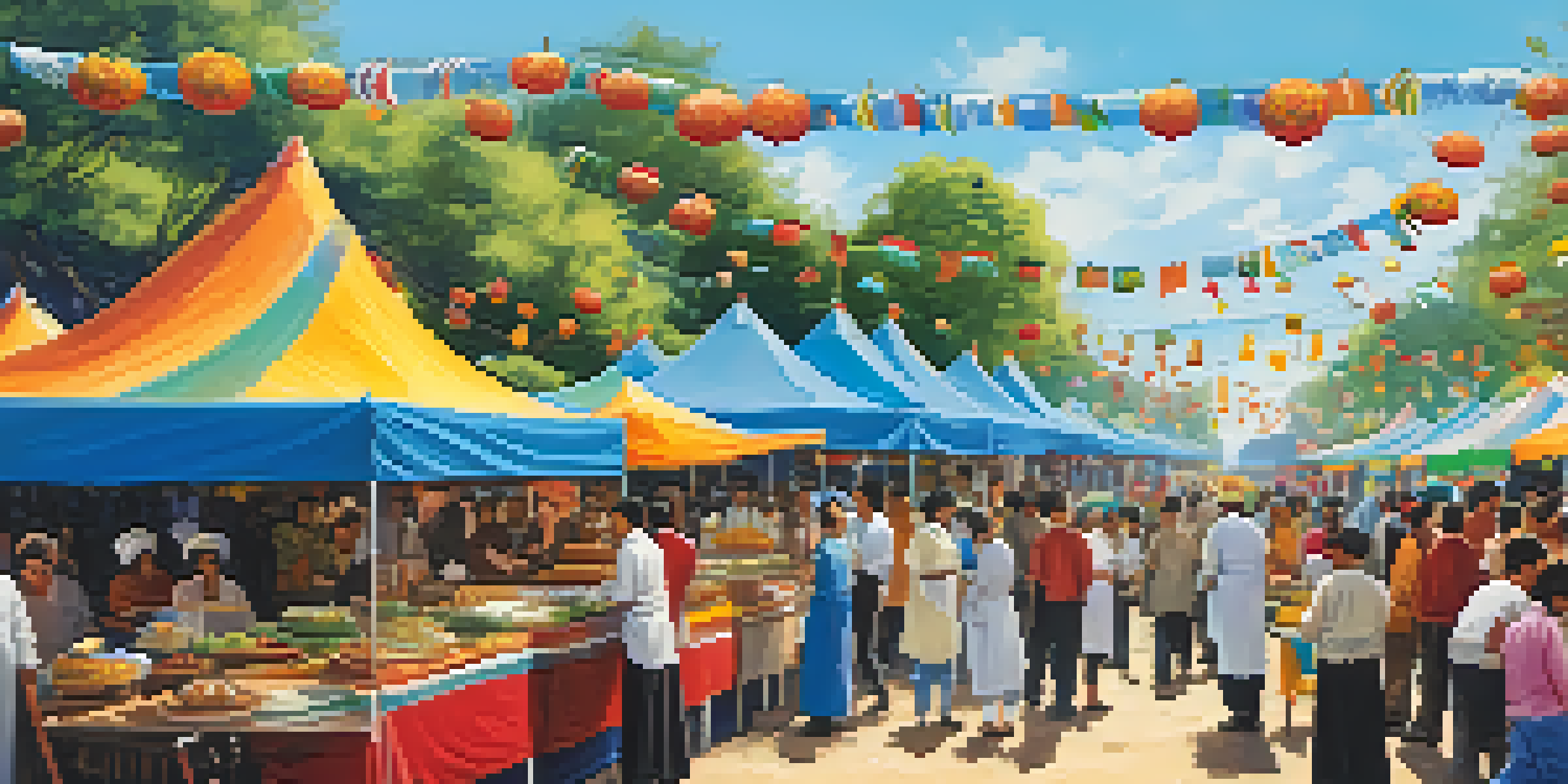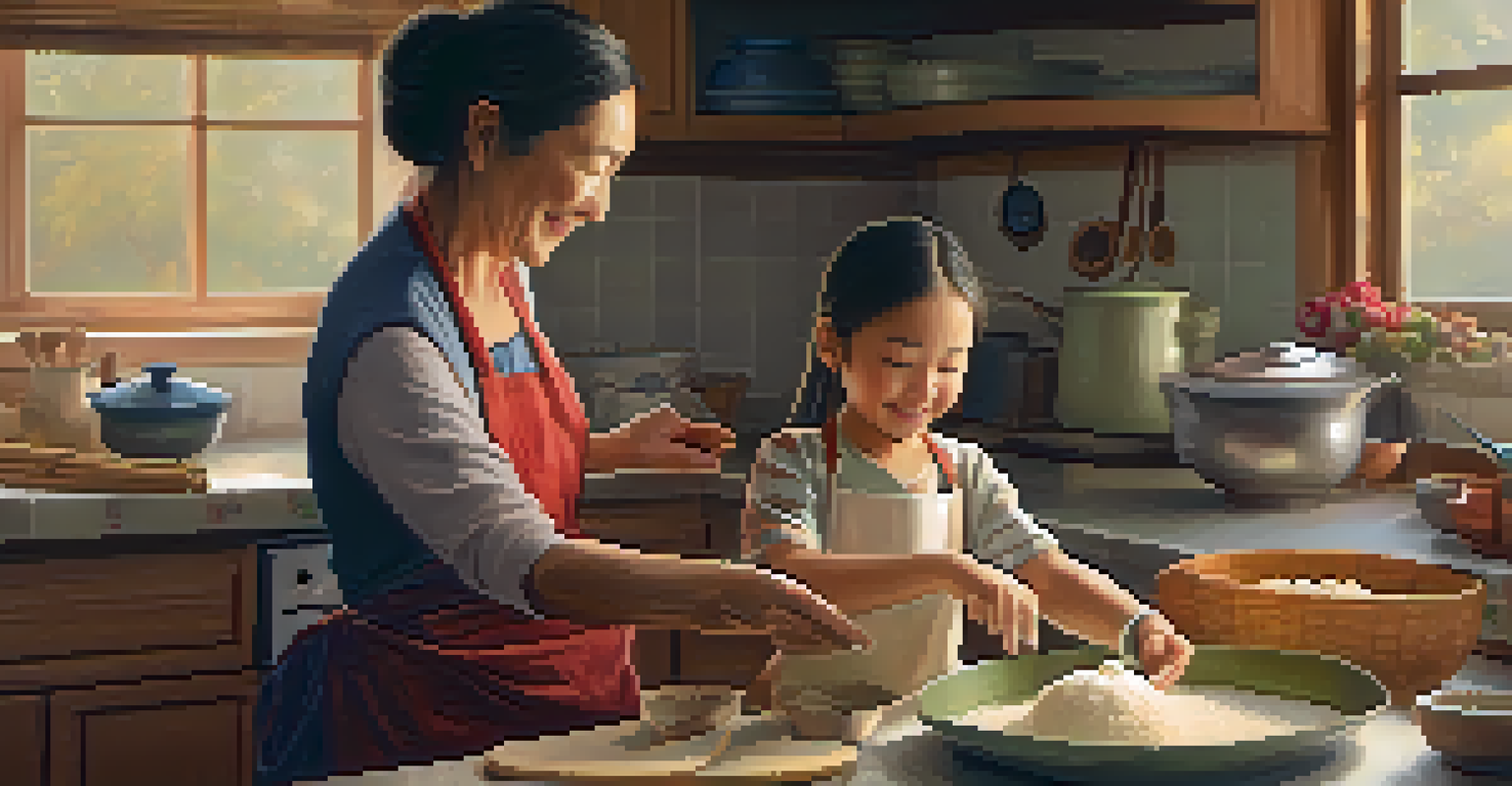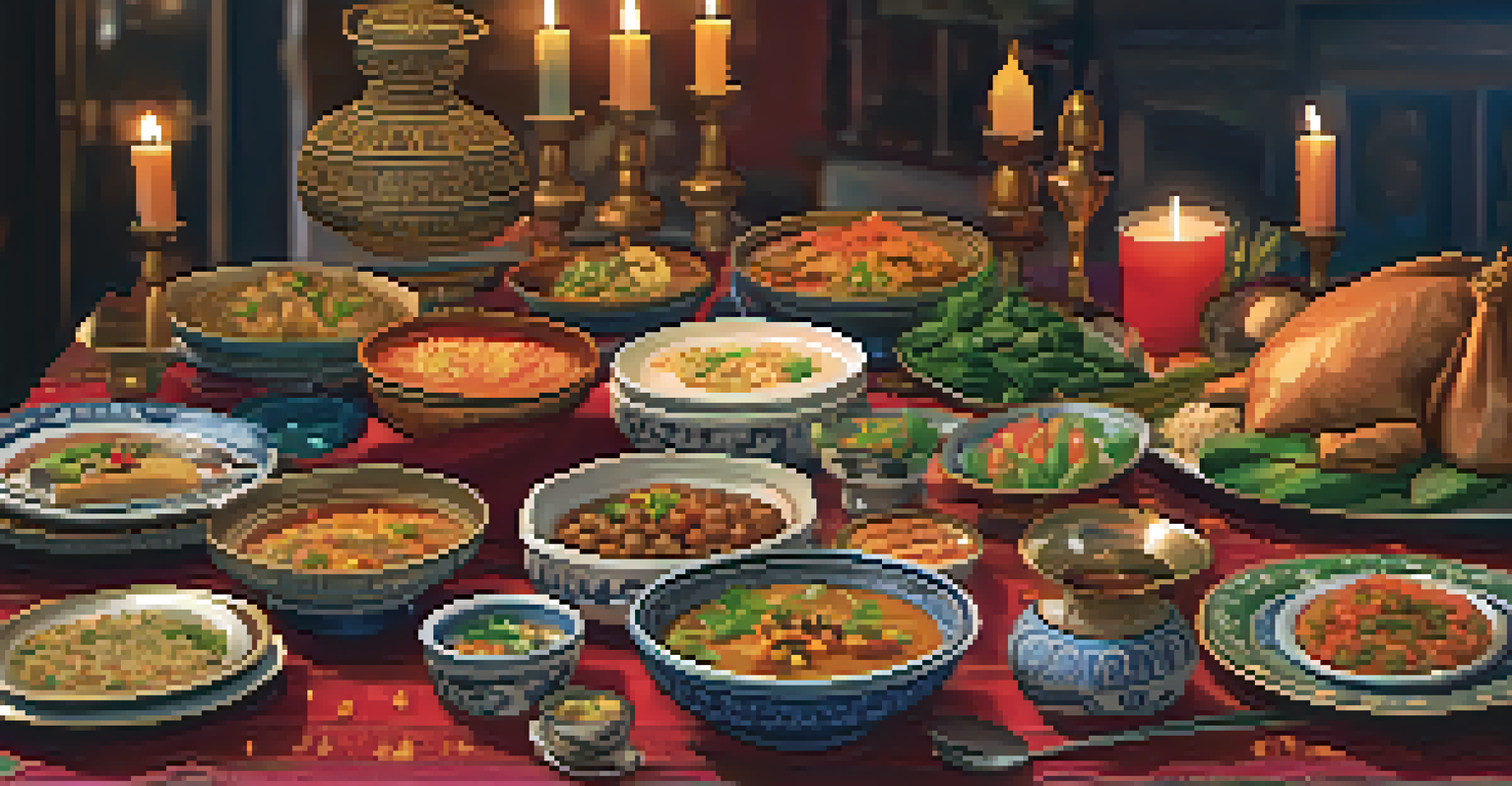Culinary Arts: Food as a Reflection of Cultural Heritage and Identity

The Essence of Culinary Arts and Cultural Heritage
Culinary arts go beyond just cooking; they serve as a vibrant expression of a culture's identity and history. Every dish tells a story, revealing the traditions, values, and experiences of the people who create it. For instance, the spices used in Indian cuisine reflect not only flavor but also the region's agricultural practices and trade routes.
Food is our common ground, a universal experience.
In many cultures, recipes are passed down through generations, preserving not just the methods of cooking but also the memories associated with them. Family gatherings often revolve around traditional dishes, creating bonds that tie people to their roots. This communal aspect of food mirrors the collective identity of a culture, showcasing how food can unite individuals through shared experiences.
Moreover, culinary arts can act as a bridge between generations, allowing younger members to connect with their heritage. When a grandparent teaches a child how to make a family recipe, it’s more than just cooking; it’s an exchange of stories and values. This intergenerational connection emphasizes the importance of food in maintaining cultural continuity.
Food as a Narrative of Identity
Food serves as a narrative that speaks volumes about who we are. Each ingredient can symbolize different aspects of cultural identity, from geography to religion. For instance, the use of pork in Southern BBQ represents a culinary tradition deeply rooted in the region's history, revealing influences from African American culture.

The preparation and consumption of food often reflect personal and communal identities. Celebrations, such as weddings or festivals, are marked by specific dishes that hold significance for the community. These culinary customs not only highlight individual identity but also strengthen the sense of belonging within a cultural group.
Food as a Cultural Connector
Culinary arts serve as a vibrant expression of cultural identity, preserving traditions and creating bonds among people.
Furthermore, the evolution of culinary practices can illustrate the dynamic nature of cultural identity. As societies change, so do their food traditions, often incorporating new influences while retaining core elements. This adaptability ensures that food remains a living reflection of cultural heritage, continuously evolving yet firmly anchored in its roots.
The Global Influence of Culinary Traditions
In our increasingly interconnected world, culinary traditions have crossed borders, leading to fusion cuisines that reflect a blend of cultures. This globalization of food showcases how cultural exchange can enrich culinary arts, creating innovative dishes that celebrate diversity. Think of sushi burritos or tacos filled with Korean BBQ; these are delicious examples of cultural melding.
Cooking is like love. It should be entered into with abandon or not at all.
However, this blending can also lead to concerns about cultural appropriation, where elements of one culture are adopted without understanding their significance. It’s crucial to approach culinary traditions with respect and awareness, acknowledging their origins and the stories behind them. By doing so, we can celebrate diversity without undermining the authenticity of the cultures involved.
Ultimately, the global influence of culinary traditions highlights the importance of dialogue and appreciation between cultures. Food can serve as a platform for discussing cultural identities, encouraging curiosity and understanding among different communities. This exchange not only enhances our palates but also fosters a greater appreciation for the rich tapestry of human experience.
The Role of Food in Cultural Rituals and Festivals
Food is often at the heart of cultural rituals and festivals, serving both practical and symbolic purposes. In many cultures, specific dishes are prepared to mark important occasions, such as harvest festivals or religious ceremonies. These culinary practices not only honor traditions but also reinforce community bonds through shared experiences.
For example, during the Chinese New Year, families prepare dumplings, symbolizing wealth and prosperity for the coming year. The act of cooking and sharing these dishes reinforces family ties and cultural beliefs, making food an integral part of the celebration. Such rituals highlight how food can encapsulate the values and aspirations of a culture.
Culinary Traditions Evolve Globally
The globalization of food has led to innovative fusion cuisines while emphasizing the importance of respecting cultural origins.
Moreover, festivals often provide opportunities for cultural expression through food. Street fairs, for instance, allow diverse communities to showcase their culinary heritage to a broader audience. This not only promotes cultural pride but also invites others to participate in the rich tapestry of flavors and traditions that define a community.
Culinary Arts as a Means of Preserving Heritage
As globalization continues to influence culinary practices, preserving traditional methods becomes increasingly important. Culinary arts offer a way to keep cultural heritage alive by maintaining recipes, cooking techniques, and food-related rituals. This preservation ensures that future generations can access and appreciate their cultural roots.
Many organizations and communities are working to document traditional recipes and cooking methods, creating cookbooks and workshops to share this knowledge. For instance, initiatives aimed at revitalizing Indigenous cuisines help highlight the significance of local ingredients and culinary practices that have been passed down through generations. These efforts underscore the importance of safeguarding culinary heritage in a rapidly changing world.
Additionally, the rise of food tourism has spurred interest in traditional cuisines, encouraging travelers to seek authentic culinary experiences. By supporting local chefs and food artisans, individuals contribute to the preservation of cultural heritage while enjoying a deeper understanding of the places they visit. This symbiotic relationship between food and culture highlights the vital role culinary arts play in preserving our shared human history.
The Intersection of Food and Cultural Identity in Modern Society
In modern society, the way we consume food often reflects our cultural identities and personal values. With the rise of dietary trends such as veganism or gluten-free diets, food choices can signify broader cultural movements. This shift illustrates how culinary arts adapt to contemporary social dynamics while maintaining their cultural significance.
Moreover, social media platforms have transformed the way we engage with food, allowing individuals to share their culinary creations and cultural narratives with a wider audience. Food bloggers and influencers often highlight traditional recipes, bringing attention to their cultural roots and inviting others to explore diverse cuisines. This digital landscape fosters a sense of community and appreciation for culinary diversity.
Food's Role in Rituals and Heritage
Food is central to cultural rituals and festivals, reinforcing community ties and encapsulating the values of a culture.
However, the challenge remains to balance authenticity with modern trends. As food becomes a medium for personal expression, it’s essential to ensure that the cultural significance of dishes is honored and respected. By doing so, we can celebrate our unique identities while recognizing the rich tapestry of culinary traditions that shape our world.
Conclusion: Celebrating Culinary Arts as Cultural Heritage
In conclusion, culinary arts offer a profound reflection of cultural heritage and identity. From traditional recipes to modern adaptations, food serves as a narrative that connects individuals to their roots and fosters community bonds. As we explore diverse cuisines, we gain insight into the values and histories that shape our world, celebrating the rich tapestry of human experience.
By recognizing the importance of food in cultural rituals, festivals, and daily life, we can appreciate the stories behind each dish. This understanding promotes respect for different culinary traditions and encourages an appreciation for the diversity of human creativity. The act of sharing food becomes a celebration of cultural identity, inviting others to partake in our unique experiences.

Ultimately, culinary arts remind us that food is not just sustenance; it’s a powerful medium for storytelling and connection. As we savor each bite, let’s honor the rich histories and traditions that have shaped our plates, celebrating the vibrant cultural heritage that food represents.